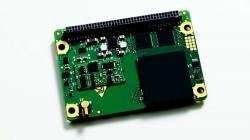The Air Force is scouring the landscape for its next round of receiver technology now that the first increment of its military receiver development program is moving into a deeper testing phase.
Though this expanded effort has to fulfill a long established requirement — the Air Force must develop a multi-service, handheld receiver — the GPS program is now also working on a congressional mandate requiring that American military equipment also incorporate signals from other nation’s satellite navigation constellations, maybe even all of those constellations.
Progress So Far
Under the Military GPS User Equipment program (MGUE), the Air Force’s GPS Directorate is developing receiver cards that will plug into existing equipment, enabling them to utilize the new military M-Code. M-Code capable receivers, which are being developed in a two-increment process, will have enhanced positioning, navigation, and timing (PNT) capabilities and be more resistant to jamming and other threats. The M-Code signal from the upcoming GPS III satellites is also supposed to be stronger.
Three contractors — L3 Technologies, Raytheon Space and Airborne Systems, and Rockwell Collins — are working to create both the cards and the cyber-secure software that goes with them. However, once the initial cards are ready and tested the Air Force will not be doing the usual direct procurement. The three contractors instead will compete to sell the cards across all the different military users.
Increment 1 focuses on receiver cards for ground equipment and aviation/ maritime uses and includes testing in four lead platforms: the Army’s Stryker ground combat vehicle; the Air Force’s B-2 Spirit bomber; the Marine Corps’ Joint Light Tactical Vehicle (JLTV); and the Navy’s DDG-51 Arleigh Burke destroyer.
This summer Raytheon’s miniaturized GPS airborne receiver, the MAGR-2K-M, underwent a successful prototype and system functional check on the B-2 — confirming the card could draw power, put out the right data and that that data was being received by the B-2 systems in the appropriate format. A year earlier L3 successfully completed the security certification process, the first of the three contractors to do so, said Director Col. Steven Whitney of the GPS Directorate.
To achieve certification, Whitney told Inside GNSS, “we’re required to make sure that the unit properly decrypts the M-Code signal. More importantly with security certification we need to make sure that the unit doesn’t release any of the critical parameter information or that the key security information is not able to get out. We want these things to be unclassified when keyed because we want young airmen, soldiers, sailors and marines to take these things and use them in the field. And if it can only be done in classified environment that’s obviously not effective.”
Rockwell and Raytheon are “coming up real close” on certification, said Whitney. Each has submitted designs whose performance will be judged against test data. “So, we’re in that conversation with each of them and they’re at different stages, as you might imagine. And I don’t want to get ahead of myself, speculating when they’re going to be done — but I would expect it in the next year or so,” he said.
“Our small form factor MGUE hardware development for both airborne and ground is stable and validated in both developmental environmental test and in receiver signal performance testing using M-Code signal simulators,” said Jade Groen, principal program manager for MGUE at Rockwell Collins in a written comment sent before the holidays. “We have also validated the receiver has achieved very low power consumption while achieving high reliability mean time between failures. We are looking forward to completing our security certification with the GPS-D in 2018.”
Increment 1 will most likely be completed in 2022, said Whitney, though a lot remains to be done. “I’ve got to complete my testing program and then we’ve got to go into our integration efforts and we’ve got to go with the operational testing,” he said, noting that the first operational tests would probably be with the Navy’s Arleigh Burke-class destroyer.

GAO: So, What’s the Plan?
Despite the progress made in Increment 1 the new cards are not ready, which creates a problem.
Concerned about slow M-Code adoption, Congress passed a law in 2011 that forbade the purchase of anything but M-Code capable receivers starting in fiscal year 2018 (FY18). Fortunately the Secretary of Defense was given the power to waive the requirement in some cases — including when M-Code receivers were not available. A blanket waiver has been granted “for at least a year,” said Whitney.
That waiver may well be extended as integration and the related engineering is shaping up to be the really complicated part of receiver modernization.
A December 12 report from the Government Accountability Office (GAO) underscores the enormity of upgrading the Pentagon’s vast inventory of GPS-enabled equipment. The overall effort will likely take more than a decade and “many billions of dollars to complete” — an estimate based on experience.
“DoD (Department of Defense) has previously transitioned its weapon systems gradually from one generation of GPS receivers to the next,” explained GAO. “For example, some weapon systems have either upgraded or are still in the process of upgrading to the current SAASM receivers that were introduced in 2003, while others are still equipped with older cards. DoD anticipates that the length of time necessary to transition to MGUE will require users to operate with a mix of receiver cards.”
So far the military has identified more than 700 types of weapons systems that will need to be upgraded — an effort requiring almost one million receiver cards. Moreover, there is significant work remaining to verify the new cards work as planned and to develop them further after the MGUE Increment 1 program ends. And, so far, the money to do all of this isn’t there.
“Of the 716 types of weapon systems that will need M-Code receiver cards,” wrote GAO, “only 28 — or less than 4 percent — are fully funded through fiscal year 2021. The remainder have either partially funded M-Code development and integration efforts (72 weapon systems), or do not yet have funding planned (616 weapon systems).”
The integration challenge is substantial, warned Cristina Chaplain, GAO’s director of acquisition and sourcing management and the lead on the December report.
“There’re technical challenges that include security and backwards compatibility,” Chaplain told a June meeting on space policy sponsored by the Mitchell Institute for Aerospace Studies and FiscalTrak. “There’s a council in place to help organize all this user equipment, but they may not have the authority to really prioritize things. So, it’s a big issue because essentially you’re going to waste capability in space if you have M-Code satellites and you don’t have the receivers on the ground to take advantage of them. Once these receivers are developed and handed over to the military services, they’re going to have to do more development themselves to get them to fit the equipment that they have, and that’s going to take time. Then they have to install these receivers on all kinds of weapons platforms, which takes up to 10 years.”
Some problems could be ameliorated if there was a centralized coordinating organization that gathered up and shared solutions to integration issues. According to the report, the MGUE Increment 1 program is already capturing all the issues observed in receiver test card risk reduction testing and sharing this information through a joint reporting system. “However,” GAO wrote, “while non-lead platforms may also report deficiencies in this system, there is no requirement that they do so, nor is there an entity responsible for ensuring data from testing, design, and development is shared between programs.”
Without such sharing and coordination, said GAO, the Pentagon “risks paying to repeatedly find design solutions to solve common problems because each program office is likely to undertake its own uncoordinated development effort. Some duplicated effort may already be occurring. Air Force officials have expressed concern that work is already being duplicated across the military services in developing embedded GPS systems to be integrated.”
The Army also has approached GAO with specific concerns about coordinating MGUE, Chaplain told attendees.
“When you have the Army folks coming to GAO to tell you they need more centralized authority on user equipment, you know there’s an issue,” she told the meeting. “You don’t go to GAO unless something is wrong.”
And Now — Increment 2
Meanwhile, as planned, the Air Force has launched into Increment 2 wherein it is to develop compact receiver cards for uses where size, weight, and power are a constraint. As noted earlier, the GPS Directorate is also tasked with developing a handheld receiver to be carried by both U.S. and allied warfighters.
“Increment 2 is currently in the requirements definition phase and we’re having a — we (meaning) the Department of Defense — is having a lengthy conversation about what needs to be in and what needs to be out in terms of the requirements,” said Whitney. As of last fall all the services were submitting requirements and discussions were underway, he said, about what was achievable versus what might be a technology leap too far. To support the debate the Air Force was doing research into the current state of technology.
Part of that research entailed a request for information on technologies available to support the handheld receiver. Special Notice 17-095, released in September, said the expected annual production rate was between 2,600 and 5,200 units per year. “There is a potential for procuring additional Handhelds (tens of thousands), the Air Force wrote, “that may be procured by other DoD Services, plus U.S. allies as Foreign Military Sales.”
Interestingly the Air Force seems open to expanding beyond its current contractor base. In addition to describing things like the needed battery life the Air Force asked responders about the business conditions they would need to enter the MGUE handheld market including the rate of return required on nonrecurring engineering investments and the payback period.
The GAO said in its report that the Air Force planned to deliver the acquisition strategy for Increment 2 in March.
That, however, was before Congress got involved. With the enactment of the National Defense Authorization Act for Fiscal Year 2018 (NDAA) lawmakers tossed a brand new requirement into the mix.
Change in Plans
Language in the report accompanying the final NDAA bill ordered the Pentagon to ensure that GPS user equipment for the military had the capability to “receive trusted signals from the Galileo satellites of the European Union and the QZSS satellites of Japan.” The Secretary of Defense must also assess “the feasibility, benefits, and risks” of having user equipment be capable of receiving non-allied signals. The details for doing all this are to be in a plan due back to Congress in June.
On December 7, the Air Force issued a pre-solicitation notice on Fed Biz Ops (number 18-022), looking for information to help it devise an acquisition strategy.
The request asked responders to look at three use cases. In the first the GPS satellite Geometric Dilution of Precision (GDOP) is insufficient or intermittent. Tactical units operating or traveling between Bagram Air Base and Kabul, Afghanistan experience GPS performance degradation due to signal blockage caused by mountains, foliage, and, in Kabul, urban buildings. The MGUE receiver knows its approximate position and is to acquire and track multi-GNSS signals for a PNT solution.
In the second use case, there is a problem affecting multiple GPS signals from multiple GPS satellites. The GPS signals are visible, but may have various anomalies that render some of them inaccurate or unreliable. The MGUE receiver is keyed, knows its approximate position and has successfully acquired one or more M-Code signals. The receiver is to remove the bad signals and attempt to acquire and track multi-GNSS signals for an improved PNT solution.
In the third case the GPS Master Control Station is dealing with an anomaly and has completely shut down its operations. The MGUE receiver has determined that the current accuracy of GPS signals is insufficient to perform the mission. With a keyed MGUE receiver and no available GPS signals the receiver must recognize the absence or degradation of usable GPS signals and attempt to use multi-GNSS signals for a PNT solution.
The non-military signals to be used for these sample cases, that is those multi-GNSS signals that can be tapped in addition to military and civil GPS signals, are:
- Galileo: E1OS, E5a
- Quasi-Zenith Satellite System (QZSS): L1C, L2C, L5
- Space Based Augmentation System (SBAS): L1, L5
Whitney said that even though the requirements process for Increment 2 is underway there is time to include requirements for a new multi-GNSS receiver — if the Pentagon decides it wants to.
“What you would you have to have happen,” he said, “is you have to have the requirements process decide that this is a capability that the department wants to include in this increment.”






